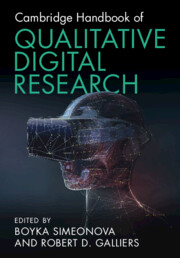Book contents
- Cambridge Handbook of Qualitative Digital Research
- Cambridge Handbook of Qualitative Digital Research
- Copyright page
- Contents
- Figures
- Tables
- Contributors
- Preface
- Part I Philosophical, Epistemological and Theoretical Considerations
- Chapter 1 Introduction
- Chapter 2 A Philosophical Perspective on Qualitative Research in the Age of Digitalization
- Chapter 3 Data as a Contingent Performance and the Limitations of Big Data
- Chapter 4 Big Data, Little Understanding
- Chapter 5 Power, Knowledge and Digitalization
- Chapter 6 Information Technology and Power
- Part II Methodological Considerations
- Part III Illustrative Examples and Emergent Issues
- Index
- References
Chapter 5 - Power, Knowledge and Digitalization
A Qualitative Research Agenda
from Part I - Philosophical, Epistemological and Theoretical Considerations
Published online by Cambridge University Press: 08 June 2023
- Cambridge Handbook of Qualitative Digital Research
- Cambridge Handbook of Qualitative Digital Research
- Copyright page
- Contents
- Figures
- Tables
- Contributors
- Preface
- Part I Philosophical, Epistemological and Theoretical Considerations
- Chapter 1 Introduction
- Chapter 2 A Philosophical Perspective on Qualitative Research in the Age of Digitalization
- Chapter 3 Data as a Contingent Performance and the Limitations of Big Data
- Chapter 4 Big Data, Little Understanding
- Chapter 5 Power, Knowledge and Digitalization
- Chapter 6 Information Technology and Power
- Part II Methodological Considerations
- Part III Illustrative Examples and Emergent Issues
- Index
- References
Summary
The chapter theorizes power, knowledge and digitalization in the digital era. It theorizes the roles of knowledge and power in the current era and how these are impacted, reinforced, redistributed, challenged and transformed through increased digitalization. The chapter develops a Knowledge-Power-Digitalization framework where the influence of episodic and systemic power on knowledge and the role of Information Systems and digitalization are outlined. The framework outlines the following quadrants: power as possession, power as asymmetries, power as empowerment and power as practice. The role of digitalization is outlined within these quadrants. The Knowledge-Power-Digitalization framework developed outlines avenues for future research in the digital era pertinent to digitalization, knowledge and power dynamics, which are important current and complex phenomena in need of qualitative research understanding and theorization.
Keywords
- Type
- Chapter
- Information
- Cambridge Handbook of Qualitative Digital Research , pp. 60 - 76Publisher: Cambridge University PressPrint publication year: 2023



